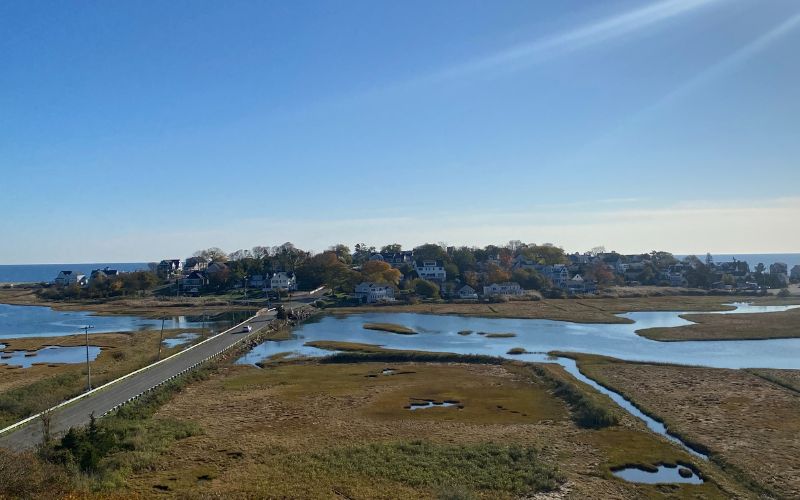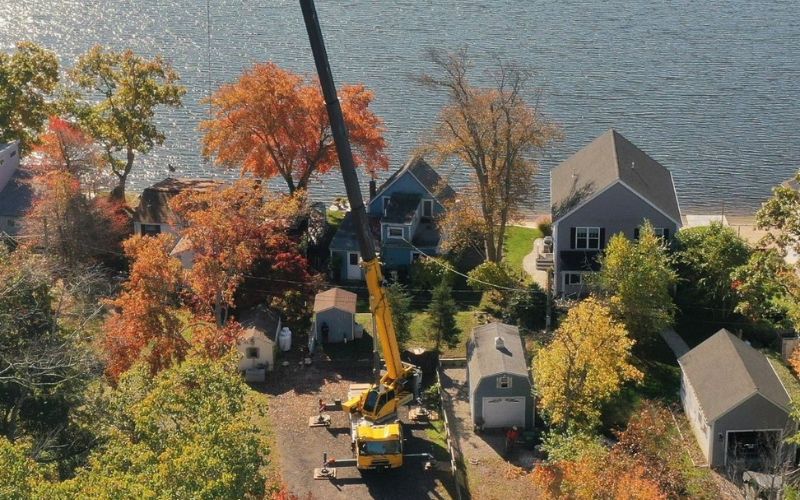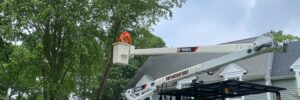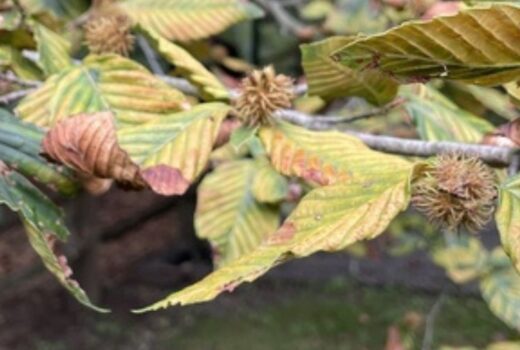Wetland areas on the South Shore of Massachusetts are an important part of our ecosystem. They’re great for stopping floods, cleaning our water, and giving a home to many animal species. But navigating the intricate maze of tree removal regulations in the Massachusetts wetlands can feel as complex as rocket science! Before you even consider chopping down that towering oak, it’s crucial to understand the legalities, environmental implications, and the steps involved. This article will guide you through this process and highlight some post-removal restoration measures.
Key Takeaways
- Understanding regulations is key before removing a tree in a Massachusetts wetland. This can help you avoid fines and adhere to the laws that govern wetland tree removal, such as the Massachusetts Wetlands Protection Act.
- Cutting down trees disrupts local wildlife habitats and ecosystems, increasing susceptibility to floods and water pollution. Consider alternatives to tree removal, such as pruning or relocation, to minimize any impacts.
- After tree removal, assess the site for damage and make repairs, replant native vegetation, and implement restoration measures to compensate for tree removal.
- Top Notch Tree is committed to helping our customers navigate the ins and outs of wetland tree removal. Our expertise can help the process go more smoothly.
What are Wetlands?
Wetlands are areas where water covers the soil, either all year or only at certain times. On the South Shore, examples include the salt marshes in Marshfield, freshwater swamps in Norwell, and the coastal bogs in Pembroke. These areas support a diverse range of plant and animal life and are crucial for environmental health.
Some areas, such as rivers, streams, ponds, wooded swamps, bogs, and cattail marshes, are easily recognizable as wetlands. However, identifying other types of wetlands and water resource areas can be trickier. If you need help determining if your property contains or borders wetlands, your local conservation commission may be able to assist you. Keep reading for information on how to find your local conservation commission and start the process.
Benefits of Wetlands on the South Shore
The wetlands on the South Shore of Massachusetts are home to a diverse variety of plants and animals. They offer shelter, food, and breeding grounds for many species. So, when you remove a tree, you’re potentially disrupting these ecosystems and threatening the survival of wildlife.
Trees in wetland areas also help improve water quality and control flood risks. They act as natural filters, absorbing pollutants and keeping them from contaminating the waters.
They also prevent flooding by acting like sponges, soaking up excess water. When trees are removed, wetland soils can become even wetter over time since the root systems of these trees no longer draw water from the ground.
In addition to improving water quality and preventing floods, trees constantly remove carbon dioxide from the atmosphere via photosynthesis in their leaves, improving air quality.

A great white egret in a saltwater marsh habitat in Massachusetts.
Environmental Effects of Tree Removal in Wetland Areas
Unfortunately, tree removal is sometimes unavoidable, especially if the tree poses a safety threat or interferes substantially with your property’s use. However, cutting down trees can severely impact local wildlife habitats and ecosystems, so it’s important to consider the implications before moving forward.
Before you decide to remove a tree, do your homework. Understand the potential environmental implications and consult with experts like Top Notch Tree if necessary. You should also explore alternatives to tree removal, such as pruning or relocation.
Remember, every action has a reaction; in this case, your decision can have far-reaching effects on the environment. Be a responsible steward of the Massachusetts wetlands.
Tree Removal in Wetlands – The Legal Do’s and Don’ts
Before you proceed, you’ll also need to understand the many laws and regulations that govern tree removal in protected wetland areas.
The Massachusetts Wetlands Protection Act
The Massachusetts Wetlands Protection Act is the first thing you should familiarize yourself with. This law protects the wetlands by regulating vegetation removal, including trees. Whether you’re a homeowner or a commercial developer, you can’t just chop down a tree without getting the right permissions.
Floodplains and Buffer Zones Are Also Regulated
Regulations also extend to floodplains and buffer zones (also called “No Disturb” zones by some local commissions). A floodplain is a type of wetland resource area that floods following storms, heavy rainfall, or snow melt. A buffer zone is the area of land within 100 feet of a wetland. Work in a buffer zone could impact the nearby wetland, so many activities in a buffer zone also require prior approval.
Visit Your Local Conservation Commissions
Your first stop should be your local conservation commission. Each town on the South Shore, like Duxbury, Hingham, or Marshfield, has its own commission. Each commission is responsible for evaluating the potential impacts on the wetland and has its own process for determining if the work should be allowed under state and local regulations.
Plan Ahead – Permitting Takes Time
The amount of time the permitting process takes will also vary, so be sure to take that into account when you’re planning your project. When you’re speaking with your local commission, be sure to ask how long the average approval process will take. You can find information about your local conservation commission by visiting your village or town website or by contacting the Massachusetts Association of Conservation Commissions.
An Impact Assessment May Be Required
Depending on the project’s size and scope, you may be asked to hire an expert to do an impact assessment to determine how the tree removal might affect the wetland area on a more detailed level. This study is performed by wetland consultants, scientists, or engineers, depending on the area of expertise needed. A list of organizations that supply these types of expertise is provided by the Massachusetts Association of Conservation Commissions.
You may also be required to take certain mitigation steps to prevent damage during removal or steps to repair any damage and restore the wetland to its original condition after removal.
Avoid Penalties!
Beware! Penalties for non-compliance can be severe. Not only could you face fines to the tune of $25,000 or higher, but you may also be required to restore the damaged wetlands. It might be expensive to do it the right way, but it’s even MORE expensive not to.
So, before you consider removing a tree from the Massachusetts wetlands, make sure you understand the legal implications. Knowledge of these laws will help you avoid unnecessary complications and penalties.
Wetland Tree Removal and Restoration Process
Congratulations! You’ve made it through all the steps of getting the approval to remove your tree. Now what? Here’s a step-by-step guide to help navigate the removal and restoration process responsibly.
This is Not a DIY Job!
First, hire a professional arborist or tree removal service. They’ll have the equipment and expertise needed to remove the tree safely. Removing a tree, especially on the unstable ground of wetland areas, is dangerous and should only be done by trained professionals.
Protect the Surrounding Area
When removing trees in a wetland area, you must take steps to protect the surrounding ecosystem. Avoid disturbing wildlife, especially during sensitive breeding seasons. Managing tree debris properly is also key. Prevent it from entering the wetland so it doesn’t impact water quality or aquatic life. Use lightweight equipment and designated pathways, when possible, to help reduce soil and plant damage.
Clean Up After Yourself
Finish by assessing the site carefully. Did the removal process cause any damage to the surrounding vegetation or soil? If so, it’s your responsibility to repair it. This could mean replanting native vegetation, installing erosion controls, or even reshaping the land to its original contours. Remember, every action you take should aim to minimize your impact on these fragile ecosystems.
So, don’t just walk away once that tree’s down. Take the time to restore your wetland area. It’s not just good practice—it’s a vital part of preserving Massachusetts’ precious wetlands.
Frequently Asked Questions
Q. Can anyone apply for a permit to remove a tree in a wetland, or do you have to be a licensed professional or an established tree service?
A. Property owners can apply for permits without the assistance of a professional. However, an expert like Top Notch Tree can help you navigate the ins and outs of the process, saving you time and lots of headaches.
Q. What are the costs associated with tree removal in the Massachusetts wetlands?
A. Tree removal costs in Massachusetts wetlands can vary greatly. Factors include tree size, location, and necessary permits. Always get a quote in writing from a reputable tree service before proceeding with the removal. It is important that you choose a company with expertise in wetland tree removal to help guide you through the process.
Q. How long does removing a tree in this area typically take?
A. The time it takes to remove a tree in the South Shore wetlands can vary. On average, it takes between a few hours to a full day, depending on the tree’s size, location, and complexity of removal. Be sure to build in time for mitigation and restoration if your project requires it.
Q. Are there specific times of the year when tree removal in wetlands is prohibited or recommended?
A. In Massachusetts, the Wetland Protection Act restricts tree removal during nesting season, typically from April to August. However, it’s always best to check with local regulations as these dates vary. You or your tree service should check with your local conservation commission during the permitting process for approved dates.
Q. Can I remove the tree myself, or do I need to hire a professional?
A. Sure, you can attempt tree removal yourself, but it’s safer to hire a professional. They’re trained to handle potential risks and complications and have all the equipment necessary to do the job properly.
Call Us Today for Tree Removal in Wetlands Areas
Understanding and respecting the delicate nature of wetlands is crucial for any tree removal activity on the South Shore of Massachusetts. If you’re considering tree removal in areas like Duxbury, Hingham, or any part of the South Shore’s wetlands, turn to Top Notch Tree. We have the expertise and experience to navigate the complexities of local regulations and the commitment to protect our precious wetlands.
For responsible, expert guidance on tree removal in wetland areas of the South Shore, call Top Notch Tree at 781-871-8008. We’re here to help!







